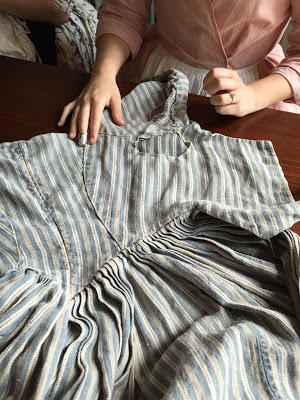The Importance of Mending, c1775
 Isabella reporting,
Isabella reporting,We've often shared beautiful clothing here on the blog, lavish silk gowns enhanced with yards of lace and ribbons. For most women living in the 18thc, however, gowns like those were as far beyond their wardrobes as haute couture Chanel is for the majority of us today.
But our 18thc sisters valued the garments that they did own much more than we do. The cost of their clothing lay in the fabric, not the labor. Last year's clothes weren't discarded when they no longer fit, fell from fashion, or showed wear. Instead they were unpicked and taken apart and remade, mended and reworked. While the more expensive dresses would be remade by professional seamstresses and mantua-makers (see examples here and here ), most mending was done at home.
Girls were taught useful darning and mending stitches as well as fancy embroidery, and though it was often called "plain sewing," the neatness of the stitches and repairs represented a skill that was anything but plain. Nor was mending an entirely feminine endeavor. Men whose work took them far from home (and thus far from obliging female family members) like sailors and frontiersmen also became adept at mending their clothing.
I was reminded of the importance of mending as I recently watched Sarah Woodyard, a journeywoman mantua-maker in the Margaret Hunter shop, Colonial Williamsburg , repairing a gown. Sarah made the gown in 2012 for apprentice blacksmith Aislinn Lewis. (See the dress when it was new in this blog post .) The fabric is a serviceable linen with indigo-blue stripes, and it's the fabric that marks this as a working-class garment. With its open-front, fitted bodice and full skirts thanks to neat rows of tiny pleats, the same style of the dress could have been made in silk for a wealthy lady.
Aislinn's work at the anvil in the blacksmith's shop has worn sizable holes in the bodice and in the underside of the sleeve where the two areas rub together. Since the rest of the dress was still in good shape, Sarah offered to mend the holes. The goal of an 18thc patch or darn was to make it as unobtrusive as possible. Statement-making patches of contrasting fabrics wouldn't even have been considered. (The checked fabric that shows in the hole of the sleeve is the sleeve's lining, not a patch.)
In the photograph, above, Sarah is patching the hole in the bodice with a scrap of the original fabric, taking care to line up the stripes; the only difference will be how the new fabric hasn't faded. She'll turn in the raw edges and overcast them, and stitch everything neatly into place. The finished effect won't be invisible, but it will give fresh life to a favorite garment - not such a bad idea in our era of fast fashion and disposable clothes.
Photograph ©2016 Susan Holloway Scott.
Published on August 10, 2016 21:00
No comments have been added yet.



